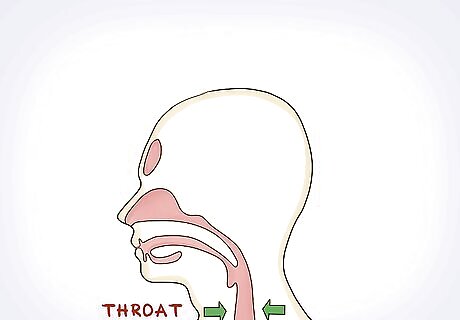
views
Simple Scream Singing

Listen to any singer who screams. Imitation is often the quickest way to learn the basics of something, and screaming is no exception. Try to find a singer who does not scream his or her entire vocals. Instead, when learning how to master this, try listening to a song where there's a scream within the song, but doesn't scream all the lyrics. As you practice your own scream, you can vary the style to suit your voice and image as desired. For now, however, focus simply on producing the basic sound and worry about tailoring it to your own tastes later on.

Drink something warm. Screaming will be much less harsh on your throat if you moisten your throat first. Something lukewarm or warm is preferably to something cold, since warm fluids can soothe the throat while cold fluids can cause the muscles to tighten and ultimately feel more sore. Warm tea with honey is one of the best options, but you could also settle for lukewarm water or room temperature juice. Avoid cold drinks. Stay away from drinks containing caffeine or alcohol, since these will only dry out your throat more.

Whisper the "ah" sound. Force out a lot of air as you whisper, but make sure that you can retain enough air to sustain the sound for 15 to 30 seconds. Take a deep breathe through your nose before you begin to get as much air into your lungs as possible. The more air you start with, the longer you can sustain the sound. Breathe out from the diaphragm. The air should be forced up from the bottom of your lungs, and you should force it out in a controlled, steady stream instead of letting it loose all at once.

Close your throat and apply more force. Narrow your throat so that there is only a small gap for you to force air through. Apply more energy to your "ah" until you can eventually feel the sound between your throat and chest. Your throat should be as tightly closed together as it can be while still allowing air to flow through.

Practice. If you take your time, it could take several weeks of consistent practice before you master this scream. You should still practice this slowly to avoid ruining your throat, though. If your throat begins to hurt as you practice your screaming, stop immediately and drink something warm. Warm tea with honey is especially good at this point. Only continue with your practice when your throat feels completely fine.
Pterodactyl Scream Singing

Drink something warm. You can maintain a sound much more clearly and protect your throat much better if you make sure that your throat is moist before you begin. Lukewarm and warm beverages tend to be better for your throat than cold fluids. Warm tea with honey is one of the best options, but you could also settle for lukewarm water or room temperature juice. Avoid cold drinks. Stay away from drinks containing caffeine or alcohol, since these will only dry out your throat more.

Form your mouth into an "e" shape. Form your mouth as though you intend to make the long "eee" sound. You do not need to actually make the sound, though. The “ee” sound is the same as the “ee” in “feet.” Exhale gently before the next part. This screaming technique produces sound on the inhale, so your lungs need to be emptied out for you to make it.

Close your throat tight. Close your throat so that only a small gap exists for you to push air through. Essentially, you should try to make this gap as small as you possibly can while still producing a sound from it. Move your tongue close to the roof of your mouth as you do this, but do not let it touch the roof. Moving your tongue in this manner should make it easier to tightly narrow your airway.

Inhale deeply. Put a great deal of energy into the inhale, activating your vocal chords as you go. You should end up producing in inhale scream or pterodactyl scream. Note that, as with the basic scream method outlined here, this method will only produce a single scream within the course of a song. You will not be able to use it to sing the lyrics of an entire song.

Practice. You will probably need to practice for several weeks at a consistent yet gradual pace before you can perform this scream correctly. Note that this technique can be more difficult to master than a basic scream, and not everyone will be able to master it. If you still cannot get the hang of it after several weeks, you would be better off sticking with a more traditional scream. An inhaled scream like this should not cause your throat to get sore like an exhaled scream will, but it is still a good idea to take breaks in between practices and drink warm tea with honey, or another warm drink, to soothe your throat.
Advanced Scream Singing

Sing the "ah" sound in falsetto. Pick a note you can sustain easily, but opt for one that is high enough to fall within your falsetto range. The pitch should be the highest one you can sing in while sustaining it without tension. Falsetto screaming is usually easier to learn than screams done in your normal vocal range. With this technique, you can learn to insert individual screams into songs or scream out lyrics. To help yourself with this step, consider playing the note you sing on a pitch wheel, keyboard, or guitar. There should be absolutely no tension on this note. If you have to push yourself to make and sustain it, drop down a pitch further and try again.

Sustain the note for as long as you can comfortably do so. Once you figure out which pitch to go with, attempt to sing it out for as long as you possibly can without straining your throat. Ideally, you should aim to hold it for 30 seconds. Keep practicing until you can hold this pitch steady for the full 30 seconds. Holding it steady means that there should be no cracking, wavering, or other variances in pitch or tonal quality.

Gargle a sip of water as you make the "ah" sound. Take a sip of lukewarm water, but instead of swallowing, begin to gargle it while making the same "ah" sound as you made earlier. Keep the same note and pitch. Pay close attention to the vibration of the uvula. The uvula is the piece of flesh hanging down from the back of your mouth. This vibration will be what you will rely on when creating a raspy scream voice. Continue gargling on the "ah" sound until you can commit this vibration to memory and feel comfortable with it.

Change to the "oo" sound. Essentially, you will be trying to create the same sound you made while gargling the water without actually gargling water anymore. Make the "oo" sound while directing air toward the soft palate of your mouth. The breath pressure should be directly applied to the top middle part of your mouth. This is the same "oo" sound as the "o" in "shoe." The soft palate is the soft tissue found at the roof of your mouth. This action should cause the uvula to vibrate as it did before. The resulting sound should be similar to the coo of a pigeon. Make sure that this is sung in the same pitch as before, and that you can sustain it for 30 seconds without the sound becoming uneven. This technique teaches you to place your tone in the soft palate, which is essential if you want to safely sustain a long scream in a song.

Switch back to the "ah" sound but use the new technique. Sing the "ah" sound in the same pitch and on the same note as before, making sure that the note is still consistent. Direct more air toward the soft palate to activate the uvula, creating a distorted "scream" note. You can direct as much air to the palate as you want as long as it does not result in straining. Manipulate your tongue, throat, and breathing using this same technique to produce different vowels, consonants, and sounds.

Practice. You will need to practice a little at a time over the course of a couple of weeks before you can really master this scream. Take your time to avoid damaging your throat. If you take your time, it could take several weeks of consistent practice before you master this scream. You should still practice this slowly to avoid ruining your throat, though. If your throat starts hurting as you practice, stop and drink something warm. Warm tea with honey is especially good at this point. Only continue with your practice when your throat feels completely fine. With enough practice, you should be able to create raspy, screaming tones without relying on the uvula. You should also be able to apply this technique to the rest of your vocal range, instead of only your falsetto voice.


















Comments
0 comment